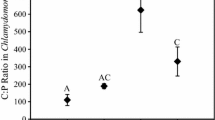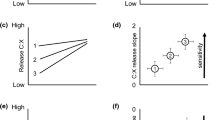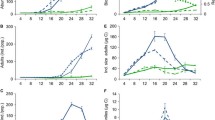Abstract
Initial theories of ecological stoichiometry were based on the assumption that the mass-specific content of key nutrient elements (such as P), changes little within a consumer species. However, evidence has shown that this content changes substantially according to feeding conditions. To clarify how the specific P content (S P) of a consumer species depends on food conditions and relates to the growth rate, we constructed a multiple mass-balance model incorporating feeding and metabolic costs and stoichiometrically regulated releases for C and P. The validity of the model was then tested experimentally by examining the growth rates and S P of Daphnia pulicaria under various food conditions. The experimental observation agreed qualitatively well with the model, showing that the S P of consumers relates positively to growth rate at high food C:P ratios but negatively at low food C:P ratios. Thus, within a consumer species, individuals with high S P do not necessarily grow at high rates. The concordance in results between the model and our observation suggests that maintenance costs for both P and C are substantial regardless of food conditions and play crucial roles in determining the relationship between the S P and growth rate of consumers.




Similar content being viewed by others
References
Acharya K, Kyle M, Elser JJ (2004) Biological stoichiometry of Daphnia growth: an ecophysiological test of the growth rate hypothesis. Limnol Oceanogr 49:656–665
Andersen T (1997) Pelagic nutrient cycles: herbivores as sources and sinks. Springer, Berlin
Andersen T, Hessen DO (1991) Carbon, nitrogen, and phosphorus content of freshwater zooplankton. Limnol Oceanogr 36:807–814
Anderson TR, Hessen DO, Elser JJ, Urabe J (2005) Metabolic stoichiometry and the fate of excess carbon and nutrients in consumers. Am Nat 65:1–15
APHA (1998) Standard methods for the examination of water and wastewater. American Public Health Association, Water Environment Federation, Washington, D.C.
Boersma M, Elser JJ (2006) Too much of a good thing: on stoichiometrically balanced diets and maximal growth. Ecology 87:1325–1330
Boersma M, Kreutzer C (2002) Life at the edge: is food quality really of minor importance at low quantities? Ecology 83:2552–2561
Carrillo P, Villar-argaiz M, Medina-Sánchez JM (2001) Relationship between N:P ratio and growth rate during the life cycle of calanoid copepods: an in situ measurement. J Plankton Res 23:537–547
DeMott WR, Pape BJ (2005) Stoichiometry in an ecological context: testing for links between Daphnia P-content, growth rate and habitat preference. Oecologia 142:20–27
DeMott WR, Tessier AJ (2002) Stoichiometric constraints vs. algal defenses: testing mechanisms of zooplankton food limitation. Ecology 83:3426–3433
DeMott WR, Gulati RD, Siewertsen K (1998) Effects of phosphorus-deficient diets on the carbon and phosphorus balance of Daphnia magna. Limnol Oceanogr 43:1147–1161
DeMott WR, Pape BJ, Tessier AJ (2004) Patterns and sources of variation in Daphnia phosphrus-content in nature. Aquat Ecol 38:433–440
Elser JJ, Urabe J (1999) The stoichiometry of consumer-driven nutrient recycling: theory, observations, and consequences. Ecology 80:735–751
Elser JJ, Dobberfuhl D, MacKay NA, Schampel JH (1996) Organism size, life history, and N:P stoichiometry: towards a unified view of cellular and ecosystem processes. BioScience 46:674–684
Elser JJ, Sterner RW, Gorokhova E, Fagan WF, Markow TA, Cotner JB, Harrison JF, Hobbie SE, Odell GM, Weider LW (2000) Biological stoichiometry from genes to ecosystems. Ecol Lett 3:540–550
Elser JJ, Acharya K, Kyle M, Cotner J, Makino W, Markow T, Watts T, Hobbie S, Fagan W, Schade J, Hood J, Sterner RW (2003) Growth rate—stoichiometry couplings in diverse biota. Ecol Lett 6:936–943
Elser JJ, Schampel JH, Kyle M, Watts J, Carson EW, Dowling TE, Tang C, Roopnarine PD (2005) Response of grazing snails to phosphorus enrichment of modern stromatolitic microbial comunities. Freshwater Biol 50:1826–1835
Fink P, Von Elert E (2006) Physiological responses to stoichiometric constraints: nutrient limitation and compensatory feeding in a freshwater snail. Oikos 115:484–494
Frost PC, Elser JJ (2002) Growth responses of littoral mayflies to the phosphorus content of their food. Ecol Lett 5:232–240
Frost PC, Xenopoulos MA, Larson JH (2004) The stoichiomery of dissolved organic carbon, nitrogen, and phoshprus release by a planktonic grazer, Daphnia. Limnol Oceanogr 49:1802–1808
Frost PC, Benstead JP, Cross WF, Hillebrand H, Larson JH, Xenopoulos MA, Yoshida T (2006) Threshold elemental ratios of carbon and phosphorus in aquatic consumers. Ecol Lett 9:774–779
He X, Wang WX (2007) Kinetics of phosphorus in Daphnia at different food concentrarions and carbon:phosphorus ratios. Limnol Oceanogr 52:395–406
Hessen DO (1990) Carbon, nitrogen and phosphorus status in Daphnia at varying food conditions. J Plankton Res 12:1239–1249
Hessen DO (1992) Nutrient element limitation of zooplankton production. Am Nat 140:799–814
Hessen DO, Rukke NA (2002) The costs of moulting in Daphnia: mineral regulation of carbon budgets. Freshwater Biol 45:169–178
Kilham SS, Kreeger DA, Lynn SG, Goulden CE, Herrera L (1998) COMBO: a defined freshwater culture medium for algae and zooplankton. Hydrobiologia 377:147–159
Kyle M, Acharya K, Weider LJ, Looper K, Elser JJ (2006) Coupling of growth rate and body stoichiometry in Daphnia: a role for maintenance processes? Freshwater Biol 51:2087–2095
Lampert W (1984) The measurement of respiration. In: Downing JA, Rigler FH (eds) A manual on methods for the assessment of secondary productivity in fresh waters. Blackwell, Oxford, pp 413–468
Lehman JT (1976) The filter feeder as an optimal forager, and the predicted shapes of feeding curves. Limnol Oceanogr 21:501–516
Logan JD, Joern A, Wolesensky W (2004) Control of CNP homeostasis in herbivore consumers through differential assimilation. Bull Math Biol 66:707–725
Main TM, Dobberfuhl DR, Elser JJ (1997) N:P stoichiometry and ontogeny of crustacean zooplankton: a test of the growth rate hypothesis. Limnol Oceanogr 42:1474–1478
McCauley E, Nisbet RM, De Roos AM, Murdoch WW, Gurney WSC (1996) Structured population models of herbivorous zooplankton. Ecol Monogr 66:479–501
Mitra A, Flynn KJ (2007) Importance of interactions between food quality, quantity, and gut transit time on consumer feeding, growth, and trophic dynamics. Am Nat 169:632–346
Olsen Y, Jensen A, Reinertsen H, Borsheim KY, Heldal M, Langeland A (1986) Dependence of the rate of release of phosphorus by zooplankton on the P:C ratio in the food supply, as calculated by a recycling model. Limnol Oceanogr 31:34–44
Plath K, Boersma M (2001) Mineral limitation of zooplankton: stoichiometric constraints and optimal foraging. Ecology 82:1260–1269
Ravet JL, Brett MT (2006) Phytoplankton essential fatty acid and phosphorus content constraints on Daphnia somatic growth and reproduction. Limnol Oceanogr 51:2438–2452
Shade JD, Kyle M, Hobbie SE, Fagan WF, Elser JJ (2003) Stoichiometric tracking of soil nutrients by a desert inset herbivore. Ecol Lett 6:96–101
Sterner RW (1990) The ratio of nitrogen to phosphorus resupplied by herbivores: zooplankton and the algal competitive arena. Am Nat 136:209–229
Sterner RW (1997) Modelling interactions of food quality and quantity in homeostatic consumers. Freshwater Biol 38:473–481
Sterner RW, Elser JJ (2002) Ecological stoichiometry: the biology of elements from molecules to the biosphere. Princeton University Press, Princeton, N.J.
Sterner RW, Hessen DO (1994) Algal nutrient limitation and the nutrition of aquatic herbivores. Annu Rev Ecol Syst 25:1–29
Urabe J (1988) Effect of food conditions on the net production of Daphnia galeata: separate assessment of growth and reproduction. Bull Plankton Soc Jpn 35:159–174
Urabe J, Watanabe Y (1991) Effect of food concentration on the assimilation and production efficiencies of Daphnia galeata G.O. Sars (Crustacea: Cladocera). Funct Ecol 5:635–641
Urabe J, Watanabe Y (1992) Possibility of N or P limitation for planktonic cladocerans: an experimental test. Limnol Oceanogr 37:244–251
Urabe J, Clasen J, Sterner RW (1997) Phosphorus limitation of Daphnia growth: is it real? Limnol Oceanogr 42:1436–1443
Van Donk E, Lurling M, Hessen DO, Lokhorst GM (1997) Altered cell wall morphology in nutrient-deficient phytoplankton and its impact on grazers. Limnol Oceanogr 42:357–364
Vrede T, Andersen T, Hessen DO (1999) Phosphorus distribution in three crustacean zooplankton species. Limnol Oceanogr 44:225–229
Vrede T, Persson J, Aronsen G (2002) The influence of food quality (P: C ratio) on RNA: DNA ratio and somatic growth rate of Daphnia. Limnol Oceanogr 47:487–494
Vrede T, Dobberfuhl DR, Kooijman SALM, Elser JJ (2004) Fundamental connections among organism C:N:P stoichiometry, macromolecular composition, and growth. Ecology 85:1217–1229
Acknowledgements
We thank J. P. Grover, M. Kyle, J. J. Elser, D. O. Hessen, R. W. Sterner, J. M. Hood and an anonymous reviewer for their invaluable comments and suggestions. This study is supported by a grant-in-aid for scientific research (B) no. 15370010 from MEXT, Japan; and by the Global Environment Research Fund (F-052) of the Ministry of the Environment, Japan.
Author information
Authors and Affiliations
Corresponding author
Additional information
Communicated by Ulrich Sommer.
Rights and permissions
About this article
Cite this article
Shimizu, Y., Urabe, J. Regulation of phosphorus stoichiometry and growth rate of consumers: theoretical and experimental analyses with Daphnia . Oecologia 155, 21–31 (2008). https://doi.org/10.1007/s00442-007-0896-7
Received:
Accepted:
Published:
Issue Date:
DOI: https://doi.org/10.1007/s00442-007-0896-7




